Without LRT, we are stuck with a stock of infrastructure we can't afford, a band of under-performing urban properties, and a cost/revenue model that puts us $200 million further into deficit each year.
By Ryan McGreal
Published May 19, 2016
This article has been updated.
This essay is adapted from a talk I gave to the Rotary Club of Hamilton Thursday Lunch meeting on May 19, 2016.
I suspect that when the organizers asked me to give this talk, they had no idea just how timely - and contentious - it would be.
Just a couple of weeks ago, I assumed I'd be giving an upbeat update on the city's preliminary LRT design plans and their public engagement strategy.
However, given recent events I think I need to spend a bit less time on the what of LRT and circle back to the why of LRT.
In May 2015, the Province announced full capital funding of $1 billion for the first phase of a light rail transit system in Hamilton. So what does that mean?
Starting with the basics, Hamilton's LRT system is broadly defined by six criteria: It is
The City recently released a preliminary design for the system with some renderings of how it will look. This design is still open to tweaks and changes, and the City will be undertaking a broad public consultation over the next several months.
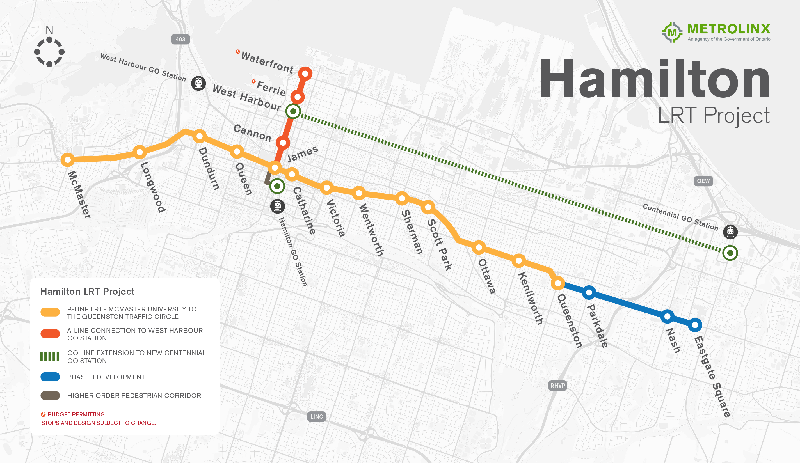
Hamilton LRT map
In brief, an east-west line will run between McMaster and Queenston Traffic Circle, and a north-south line will run on James North between King and West Harbour GO Station or, if budget allows, right to the waterfront.
This north-south line is the first part of the A-Line, which the City has identified as the next rapid transit priority after the east-west B-Line is completed. Eventually, the A-Line will extend to the escarpment and along Upper James to the airport.
There are very good reasons why the City and Province decided to focus on the east-west route as phase 1:
Existing transit ridership along this route is already very strong, making up some 40 percent of total rides on Hamilton transit. There has been a B-Line express bus since 1986, and ridership along the corridor grew 20 percent in just five years from 2009 to 2014.
The east-west line connects a number of major destinations, trip generators and employment centres. The downtown core, for example, is the city's biggest employment centre with 25,000 jobs and growing.
The east-west line also has the most potential for economic uplift through new private investment in transit-oriented developments.
This is actually the biggest reason to go through the trouble of investing in LRT. Combined with supportive land-use policy, LRT is a huge driver of investment, encouraging high-quality infill development that increases the city's property tax revenue and reduces its per-capita infrastructure costs.
A study was recently done for the City of Halifax to quantify the cost of providing municipal infrastructure and service to suburban dwellings and urban dwellings.
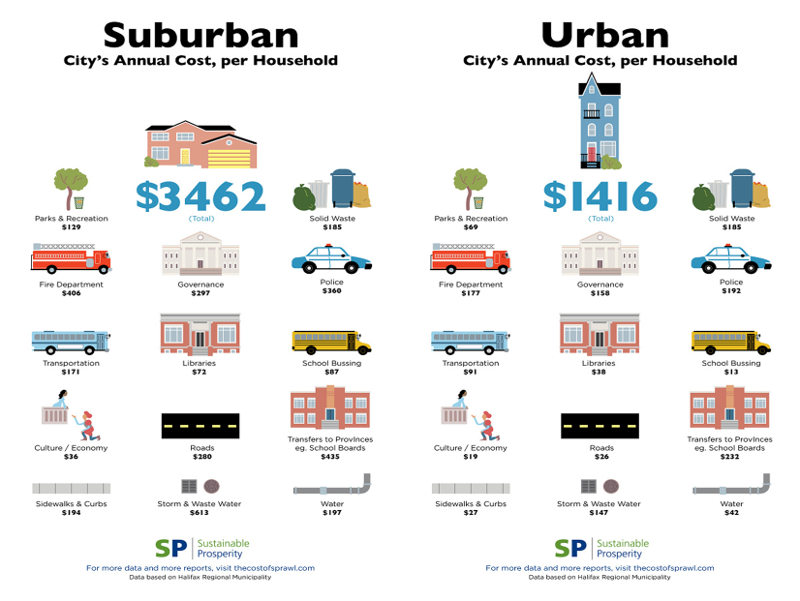
Suburban vs Urban annual cost per household in Halifax
The difference is stark: more than twice the cost per household to service suburban land use compared to urban land use.
This is a crucial lesson for Hamilton, because we are currently growing in an unsustainable way. For decades we have been growing out rather than up, and the result is a cumulative infrastructure maintenance and lifecycle backlog that is over $3 billion - and growing by $200 million a year.
That's the cost side. Now consider the revenue side. A couple of years ago, the Hamilton-Burlington Society of Architects (HBSA) held a "Tactical Taxation" event in which they brought in Joe Minicozzi, an architect and planner who has done property tax by area analyses for a number of cities.
Comparing the property tax revenue per acre for a variety of developments in Hamilton, he showed the flipside of that Halifax analysis. Based on his research methods, Young Architects Hamilton (YAH) and the HBSA produced research on the tax revenue per acre for selected Hamilton projects.
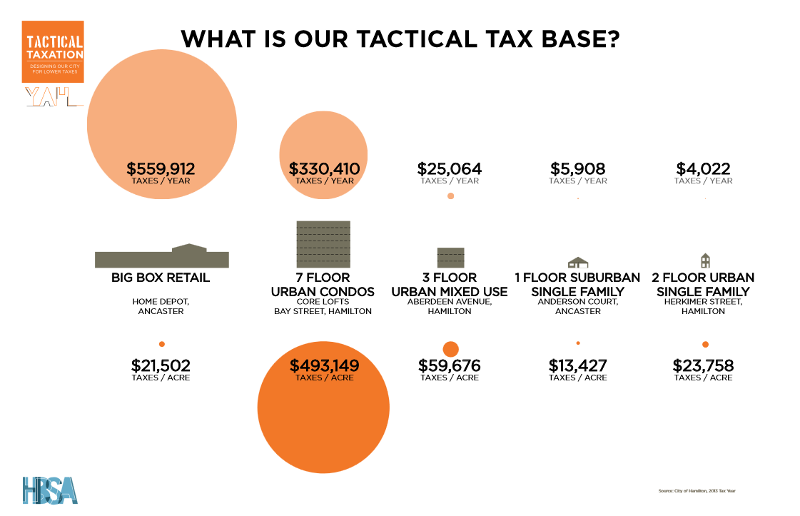
Infographic: What is our tactical tax base?
For example:
Big-box retail like the Home Depot in Ancaster generates $21,500 in property tax per acre; whereas
Dense infill like the Core Lofts on Bay Street generates a whopping $493,000 in property tax per acre!
If we look at just a few other recent developments downtown, we can see just how dramatically the City's revenue per unit of area can climb when you increase the intensity of land use.
Take, for example, the new retail and commercial building on 123 James Street North (at Vine).
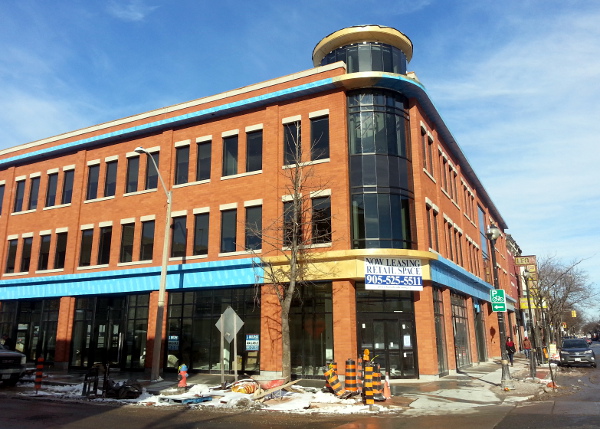
123 James Street North (RTH file photo)
When it was a vacant lot, it was valued at $371,000 and the city received just $9,000 a year in property tax revenue.
After it was redeveloped as a three-storey building, the assessed value increased to $3.8 million and the city now collects $93,000 in property tax - a tenfold increase.
Here are just a couple of more examples:
68 George Street went from paying $11,211 in municipal tax before it was developed into Staybridge Suites to paying $228,762 after.
40 Bay Street South went from paying just $18,000 a year in municipal tax before it was developed into Homewood Suites to paying $390,996 after.
Every new development that builds up rather than out increases the city's property tax revenue without increasing its infrastructure obligations.
Now think of all the properties in the half-kilometre or so corridor on either side of the east-west LRT line that are ripe for redevelopment. The following aerial shot is by photographer Anita Thomas.
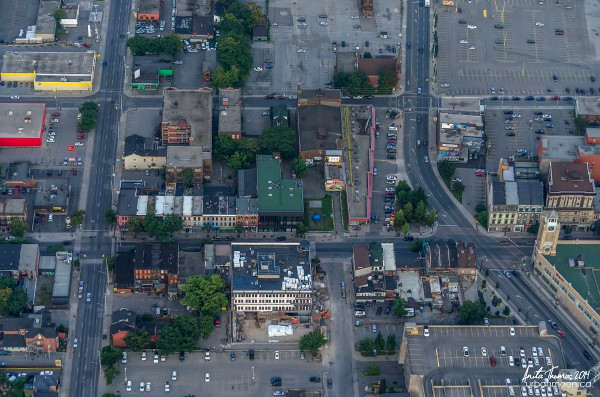
Surface parking lots downtown (Image Credit: Anita Thomas)
There are whole city blocks in which the only building is the hut where you pay to park.
That's a huge opportunity to increase the city's density, property tax revenue and economic dynamism while actually improving our ability to manage our infrastructure lifecycle costs.
LRT allows us to meet the Provincially-mandated minimum infill target, which is currently 40% but set to increase to 60%.
It also allows us to do a much better job of attracting the young people, including young technical professionals and entrepreneurs, that Hamilton needs to generate the next wave of prosperity.
Business leaders in Hamilton say it's hard to attract young people to Hamilton today because they see it as a backwards city that is still governed on the assumption that most people will drive for most trips.
Meanwhile, it has already become a truism that young people today no longer equate owning a car with freedom the way people my age and older did. The culture has changed, and the steadily falling number of young people with drivers licences bears this out.
Instead of a form of freedom, driving increasingly looks to young people like an expensive burden they would rather avoid.
I want young people to be able to see and build a future in Hamilton - but the city needs to do a better job of understanding what young people want and need from a city. LRT is an essential ingredient in getting us there.
Another central benefit of higher density development is that it is actually proven to increase a city's rate of economic growth.
When you bring people and destinations closer together, you get more meetings, more ideas, more partnerships, more business start-ups, lower cost of doing business, easier access to bigger markets, and the cross-benefits of clustering and agglomeration.
By driving higher-order land use, LRT can help simultaneously lower Hamilton's cost of providing municipal service while increasing the city's rate of innovation and growth.
There's another thing, too. This map highlighting parking and vacant lots in the downtown core was developed by Chris Higgins of McMaster.
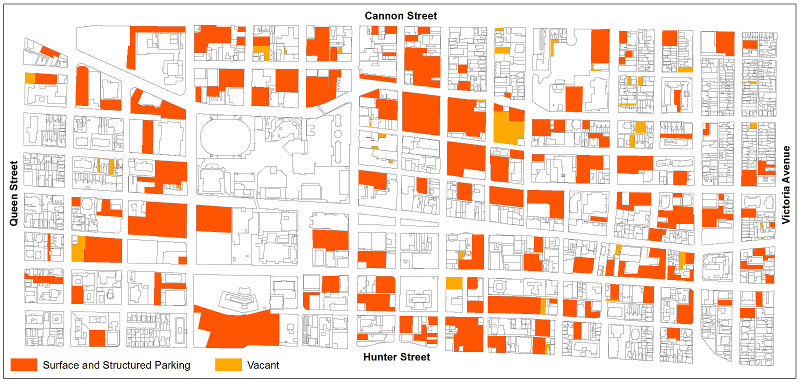
Downtown Hamilton surface parking and vacant lots (Image Credit: Chris Higgins)
Long-time Hamiltonians tend to look at images like this and either shrug that it's just "normal" for so much of the downtown core to be low-value land use, or else despair that nothing will change.
New Hamiltonians look at images like this and all they see is an exciting opportunity to create new things.
We need that optimism. We need that enthusiasm. We need that refreshing lack of cynicism.
Some people - including some councillors who know better - have suggested that we should use the $1 billion LRT funding to chip away at that infrastructure backlog instead.
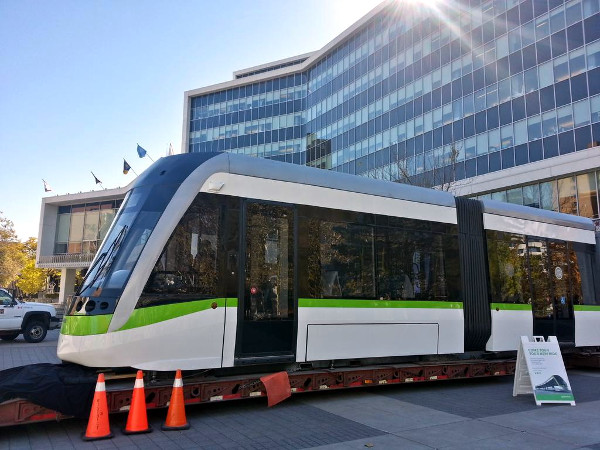
LRT vehicle on display at City Hall last year (RTH file photo)
First of all, the Province has made it very clear that the money is for LRT, not for a grab-bag of municipal wish list items.
If we don't use the money for LRT, we don't get the money - and some other city in Ontario would be only too happy to take it.
Second, even if we were allowed to spend the money filling a backlog of potholes, at the end of the day we would be in exactly the same situation we are now.
We would still have a stock of infrastructure we can't afford, a band of under-performing urban properties, and a cost/revenue model that puts us $200 million further into deficit each year.
LRT is truly a game-changer. It will transform this city, changing our long-term trajectory in ways that future generations will look back and study.
But change is scary, and some people are suddenly waking up to just how big of a change we're talking about. I think that's why some councillors are getting cold feet.
What should really scare us is the unconscionable risk that we will turn our backs on this once-in-a-generation opportunity and remain stuck in a status quo that stopped working a long time ago.
Please take a few moments to tell Council to take YES for an answer, reaffirm its support for LRT and accept the full capital funding from the Province that Council has consistently voted for since 2008.
Update: updated to clarify that the tax revenue research was cone by YAH and HBSA based on Joe Minicozzi's research methods
By KevinLove (registered) | Posted May 19, 2016 at 14:53:19
Ryan,
Excellent article!
Particularly telling is the photograph and map of surface car parking lots in downtown Hamilton.
When I took my undergraduate degree at the University of Toronto, downtown Toronto was similar. Today, those have almost all been converted to high-density use. Hamilton can and will do the same, if we have the vision and foresight to make it happen.
A soon-to-be example of property tax uplift is the former James Street Baptist church. As a church, it paid zero property tax. When the condo conversion is over, that property will pay a lot of taxes. And all the municipal infrastructure is already in place.
By Stan (anonymous) | Posted May 19, 2016 at 15:02:52 in reply to Comment 118697
We just need to put an end to the buffoonery that is our present day council meetings. We need the ass-clowns to get out of the way.
By Jeff_Tessier (registered) | Posted May 19, 2016 at 19:21:44
Ryan, how was your talk received by the Rotary Club?
By TAXPAYER (anonymous) | Posted May 19, 2016 at 19:39:38
A waste of money. Likely another over budget failure like everything the Liberal Government has done. Examples galore- Ornge, mars, e health, green energy over payments for feed in tariffs, bribery equaling 80 million to teacher unions to finance Liberal advertising, closed gas plants to save 2 Liberal MPPs in last election, opening two other plants in less sensitive areas, then recently announcing they will be closed because gas plants contribute to greenhouse gases. This government and the previous government led by Dalton McGinty have proven themselves incapable wasteful and incompetent. Oh and don't forget the UP express fiasco speaking of botched jobs intransportation. But don't worry you won't hear about it because there will be some hard drives wiped clean no doubt.
By Act Local (anonymous) | Posted May 19, 2016 at 21:40:47 in reply to Comment 118701
Ryan has just explained that our past Councils' "planning" has put Hamilton in a hole where we have "a cumulative infrastructure maintenance and lifecycle backlog that is over $3 billion - and growing by $200 million a year" and you're ranting about the Province??? Think local. Act local. Take the money and well thought out plans based on the advice of experts and citizens and work like hell to improve the mess of a backyard we've created. (Note that much of our current Council is part of said past ones.)
By mdrejhon (registered) - website | Posted May 19, 2016 at 21:15:44 in reply to Comment 118701
The UPX is no longer a fiasco -- they have dramatically cut the fares to UPX and ridership has now tripled. They are now planning to merge it into GO RER, as part of transit too, when they electrify UPX.
While it is okay to argue Ontario wasted money on various projects, this does not mean all Ontario projects are a taxpayer waste. Crosstown LRT is currently on budget and using good LRT design principles, and will be fare integrated into TTC.
I have my disagreements (e.g. I do not like the Hydro One sale) but the LRT is not an inefficiently spent project for Hamilton.
By arienc (registered) | Posted May 20, 2016 at 08:13:52 in reply to Comment 118704
An important lesson for all rapid transit projects - it must be integrated into the local system, and pricing must be part of that integration. Plunking down a rail line on top of existing and expecting to get a premium price was a failure. Vancouver had it right with the Skytrain - a small fee on top for the airport access but otherwise no different from the rest of the regional system.
By LRT (anonymous) | Posted May 19, 2016 at 20:46:15
As if the conservatives are any better? Quite being so naive. Either way, we, the public need higher order transit. UP express was a good idea, but fares way too high. Over time it will hopefully prove itself to be worthwhile. LRT is set to be more successful from the get go.
By mdrejhon (registered) - website | Posted May 19, 2016 at 21:10:21 in reply to Comment 118702
Metrolinx dramatically cut the fares to UPX and ridership has now tripled
Comment edited by mdrejhon on 2016-05-19 21:15:31
By Crispy (registered) | Posted May 20, 2016 at 08:07:29 in reply to Comment 118703
True, however that still isn't enough revenue to cover its operation.
By Haveacow (registered) | Posted May 20, 2016 at 11:11:56 in reply to Comment 118712
@By Crispy nearly none of our would make an operating profit as well. I work in the planning industry and currently every rapid transit project in Ontario has to go through some type of commercial cost benefit analysis test so that the project's commercial viability can be tested. Even UPX went through it. It doesn't mean every rapid transit project must or will make a operating profit. What's so annoying is that, nearly all major road projects are never put through this same test. Do you know why? This was admitted to me by a senior transport engineering specialist, It's because nearly 90% of all road major road projects would fail the same test miserably! Even when you add user fees many of these road projects still fail financially! Most of our roads and road projects just like our rapid transit system projects do not pay for themselves! They never will they all require taxes! We as a society just seem to give road projects a pass in this part of the planning process!
By rev neut (anonymous) | Posted May 20, 2016 at 08:17:58 in reply to Comment 118712
none of our transportation systems make enough revenue to cover operations. that's why we have general taxes.
By Crispy (registered) | Posted May 20, 2016 at 08:40:04 in reply to Comment 118714
Yes ridership has tripled but there is still a $20 million a year short fall. I'd rather have that $20M go to other programs.
By kevlahan (registered) | Posted May 20, 2016 at 09:12:58 in reply to Comment 118717
Our municipal roads have a $100 million annual shortfall...maybe we should increase the user fees from $0.
By Haveacow (registered) | Posted May 20, 2016 at 07:56:57
All in all that was a great article Ryan! As for @TAXPAYER's comments about the Liberals wasting money, its curious that after the common sense revolution in the 1990's and the extreme damage it did to the province and its economy, this a comment from not me but other fiscal conservatives economists in the US. I find it interesting that since then, every and I mean every, provincial Conservative Party election platform since then that used it as their platform's economic underpinning, has never been able to form a government! The Ornge debacle aside, a clear case of corruption at all levels not just the government but corporate as well, the liberals have been using an ever shrinking number of policy instruments to try and restart a new type of manufacturing in Ontario, with mixed results.
The Rapid Transit & LRT building program throughout the province is about modernizing a transportation system due to the fact that, the world wide the automobile sector is shrinking because all over the developed world fewer and fewer young people want or can afford the hassle of car ownership. The switch to from fossil fuels powered vehicles and driverless cars will only in the next 20-30 years increase the cost of a car, not make it less! This is from the president of Honda!
If you live in North America and are approaching 70 be warned, the entire insurance industry wants every state and province to have yearly driving test for everyone over 70. They usually, eventually, get their way! Not just a vision test but a hand to eye coordination timing response test as well! Failure of just one test means forever losing your license. There are just too many seniors having too many expensive to insure accidents now (too many seniors wiping out porches of homes, crowded bus stops or turning sit down restaurants into drive-through's because they mixed the accelerator and brake pedal). The aging Babyboomers will only make this problem worse.
Unfortunately, many (although not all) seniors can't cycle everywhere. Your only answer is more high occupancy public transit inside and around cities and a lot more money spent on basic public transit.
By KevinLove (registered) | Posted May 20, 2016 at 10:00:47 in reply to Comment 118711
You forgot to mention that it was Mike Harris who removed the driving test for car drivers 80 years old and older.
Thanks for all the deaths, Mike!
Comment edited by KevinLove on 2016-05-20 10:05:59
By comment sense (anonymous) | Posted May 20, 2016 at 08:19:20 in reply to Comment 118711
yes!
You must be logged in to comment.
There are no upcoming events right now.
Why not post one?